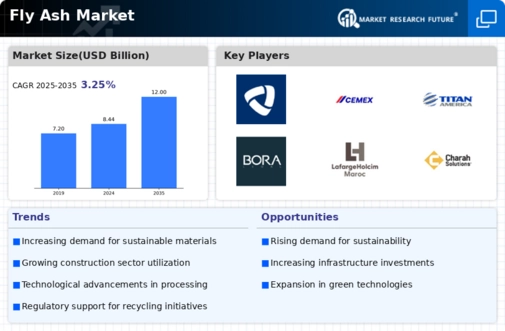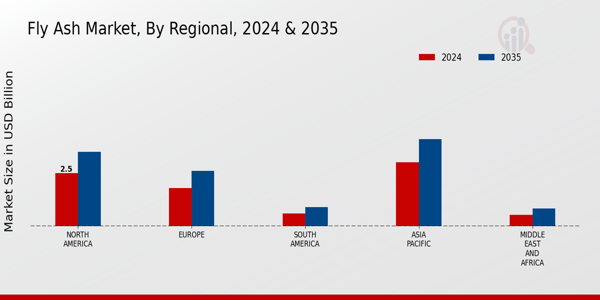Government Regulations and Initiatives
Government regulations promoting the use of recycled materials in construction significantly influence the Global Fly Ash Market Industry. Various countries are implementing policies that encourage the utilization of fly ash to minimize landfill waste and reduce environmental impact. For instance, regulations in the European Union mandate the use of secondary raw materials in construction, which includes fly ash. Such initiatives not only support environmental sustainability but also create a favorable market environment for fly ash producers. As these regulations become more stringent, the market is likely to expand, contributing to an anticipated growth to 12 USD Billion by 2035.
Rising Awareness of Environmental Benefits
There is a growing awareness of the environmental benefits associated with the use of fly ash in construction, which is positively impacting the Global Fly Ash Market Industry. Stakeholders, including builders, architects, and consumers, are increasingly recognizing that fly ash can significantly reduce greenhouse gas emissions and conserve natural resources. This heightened awareness is leading to a shift in preferences towards materials that support sustainable building practices. As more construction projects incorporate fly ash, the market is likely to see sustained growth, driven by the collective efforts of various stakeholders to promote environmentally responsible construction.
Growing Infrastructure Development Projects
The ongoing expansion of infrastructure development projects worldwide is a key driver for the Global Fly Ash Market Industry. Governments and private sectors are investing heavily in infrastructure, including roads, bridges, and buildings, which require substantial amounts of concrete. Fly ash serves as an effective additive in concrete, improving its properties while reducing costs. As countries prioritize infrastructure development to boost economic growth, the demand for fly ash is expected to rise. This trend is particularly evident in emerging economies, where rapid urbanization is driving the need for durable and sustainable construction materials.
Technological Advancements in Fly Ash Processing
Technological innovations in the processing and utilization of fly ash are transforming the Global Fly Ash Market Industry. Advanced techniques for the collection, processing, and application of fly ash are enhancing its quality and performance in construction applications. Innovations such as improved separation technologies and enhanced chemical treatments are enabling higher-grade fly ash to be produced, which can be used in a wider range of applications. This trend is likely to stimulate market growth, as higher quality fly ash can command better prices and attract more users. The market's growth is expected to maintain a CAGR of 3.25% from 2025 to 2035.
Increasing Demand for Sustainable Construction Materials
The Global Fly Ash Market Industry is experiencing a surge in demand driven by the construction sector's increasing focus on sustainability. Fly ash, a byproduct of coal combustion, is being utilized as a partial replacement for Portland cement in concrete production. This not only reduces the carbon footprint of construction projects but also enhances the durability and strength of concrete. As urbanization accelerates globally, the market is projected to reach 8.44 USD Billion in 2024, reflecting a growing preference for eco-friendly materials. The integration of fly ash in construction practices aligns with global sustainability goals, further propelling its adoption.


















Leave a Comment